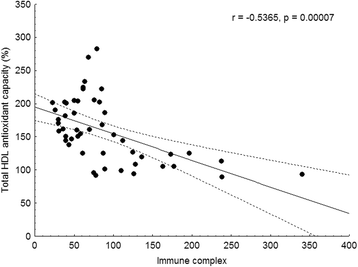High-density lipopoprotein antioxidant capacity, subpopulation distribution and paraoxonase-1 activity in patients with systemic lupus erythematosus
- PMID: 27004558
- PMCID: PMC4802594
- DOI: 10.1186/s12944-016-0229-0
High-density lipopoprotein antioxidant capacity, subpopulation distribution and paraoxonase-1 activity in patients with systemic lupus erythematosus
Abstract
Background: The causes of increased cardiovascular risk in systemic lupus erythematosus (SLE) are not understood thoroughly, although presence of traditional cardiovascular risk factors and disease-specific agents were also proposed. In this study, we investigated the quantitative changes in the lipid profile, as well as qualitative characteristics of high-density lipoprotein (HDL) and markers of inflammation and disease activity in SLE patients.
Methods: Lipoprotein levels were determined in 51 SLE patients and 49 healthy controls, matched in age and gender. HDL antioxidant capacity was determined spectrophotometrically with a cell-free method of hemin-induced low-density lipoprotein (LDL) oxidation. Polyacrylamide gel-electrophoresis was used for HDL subfraction analysis. Human paraoxonase-1 (PON1) activity, apolipoprotein A1 (ApoA1) and oxidized LDL concentrations, as well as interleukin-6, high-sensitivity C-reactive protein, serum amyloid A and monocyte chemotactic protein-1 levels were determined.
Results: HDL-cholesterol and ApoA1 concentrations decreased significantly in SLE subjects. Also, PON1 arylesterase activity (125.65 ± 26.87 vs. 148.35 ± 39.34 U/L, p = 0.001) and total HDL antioxidant capacity (165.82 ± 58.28% vs. 217.71 ± 54.36%, p < 0.001) were significantly reduced in patients compared to controls. Additionally, all HDL subfraction concentrations were significantly decreased in patients, while the levels of the examined inflammatory markers were significantly elevated in SLE subjects. The latter correlated positively with disease activity, and negatively with HDL concentration and total HDL antioxidant capacity, respectively. PON1 arylesterase activity and erythrocyte sedimentation rate were independent predictors of total HDL antioxidant capacity.
Conclusions: Induced by the systemic inflammation, altered composition and antioxidant activity may diminish the anti-atherogenic effect of HDL and therefore may contribute to the increased cardiovascular risk of SLE patients.
Keywords: HDL antioxidant capacity; HDL subfractions; SLE; cardiovascular disease; oxidized LDL; paraoxonase-1.
Figures
Similar articles
-
Altered lipid subfraction profile and impaired antioxidant defense of high-density lipoprotein in Smith-Lemli-Opitz syndrome.Pediatr Res. 2015 May;77(5):703-9. doi: 10.1038/pr.2015.33. Epub 2015 Feb 10. Pediatr Res. 2015. PMID: 25668223
-
Antibodies to high-density lipoprotein and beta2-glycoprotein I are inversely correlated with paraoxonase activity in systemic lupus erythematosus and primary antiphospholipid syndrome.Arthritis Rheum. 2002 Oct;46(10):2686-94. doi: 10.1002/art.10542. Arthritis Rheum. 2002. PMID: 12384928
-
Synergistic effects of BuChE non-UU phenotype and paraoxonase (PON1) 55 M allele on the risk of systemic lupus erythematosus: influence on lipid and lipoprotein metabolism and oxidative stress, preliminary report.Lupus. 2014 Mar;23(3):263-72. doi: 10.1177/0961203313518622. Epub 2014 Jan 7. Lupus. 2014. PMID: 24399815
-
High-density lipoprotein functionality in systemic lupus erythematosus.Semin Arthritis Rheum. 2020 Aug;50(4):769-775. doi: 10.1016/j.semarthrit.2020.05.011. Epub 2020 May 25. Semin Arthritis Rheum. 2020. PMID: 32531506 Review.
-
How HDL protects LDL against atherogenic modification: paraoxonase 1 and other dramatis personae.Curr Opin Lipidol. 2015 Aug;26(4):247-56. doi: 10.1097/MOL.0000000000000194. Curr Opin Lipidol. 2015. PMID: 26103614 Review.
Cited by
-
HDL in Immune-Inflammatory Responses: Implications beyond Cardiovascular Diseases.Cells. 2021 Apr 29;10(5):1061. doi: 10.3390/cells10051061. Cells. 2021. PMID: 33947039 Free PMC article. Review.
-
The causal relationship between 25-hydroxyvitamin D and serum lipids levels: A bidirectional two-sample mendelian randomization study.PLoS One. 2024 Feb 14;19(2):e0287125. doi: 10.1371/journal.pone.0287125. eCollection 2024. PLoS One. 2024. PMID: 38354201 Free PMC article.
-
Lipid Metabolism: Immune Regulation and Therapeutic Prospectives in Systemic Lupus Erythematosus.Front Immunol. 2022 Mar 18;13:860586. doi: 10.3389/fimmu.2022.860586. eCollection 2022. Front Immunol. 2022. PMID: 35371016 Free PMC article. Review.
-
A Panel of Biomarkers Associates With Increased Risk for Cardiovascular Events in Women With Systemic Lupus Erythematosus.ACR Open Rheumatol. 2021 Apr;3(4):209-220. doi: 10.1002/acr2.11223. Epub 2021 Feb 19. ACR Open Rheumatol. 2021. PMID: 33605563 Free PMC article.
-
The role of triglycerides in predicting new-onset arthritis in the general population over 45 years old: evidence from the China health and retirement longitudinal study.Front Endocrinol (Lausanne). 2025 May 8;16:1530874. doi: 10.3389/fendo.2025.1530874. eCollection 2025. Front Endocrinol (Lausanne). 2025. PMID: 40405982 Free PMC article.
References
-
- Manzi S, Meilahn EN, Rairie JE, Conte CG, Medsger TA, Jansen-McWilliams L, D'Agostino RB, Kuller LH. Age-specific incidence rates of myocardial infarction and angina in women with systemic lupus erythematosus: comparison with the Framingham Study. Am J Epidemiol. 1997;145:408–15. doi: 10.1093/oxfordjournals.aje.a009122. - DOI - PubMed
Publication types
MeSH terms
Substances
LinkOut - more resources
Full Text Sources
Other Literature Sources
Medical
Research Materials
Miscellaneous




